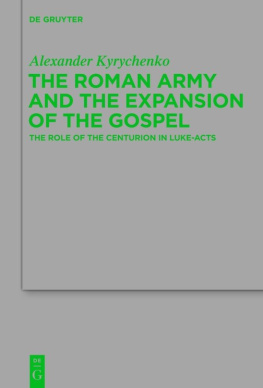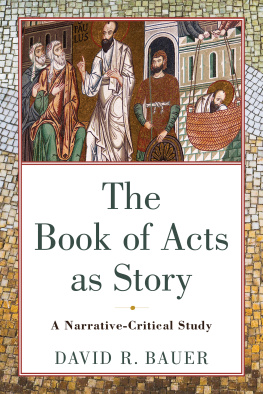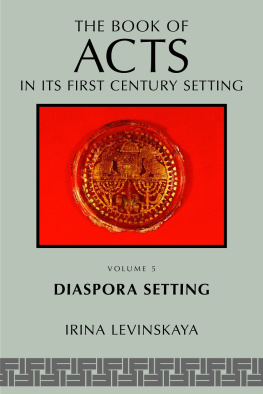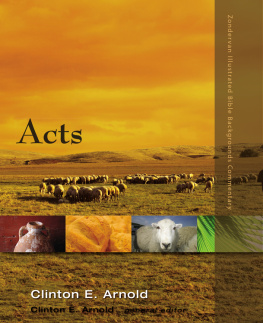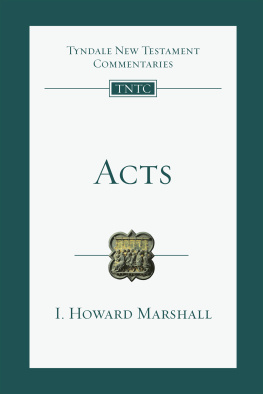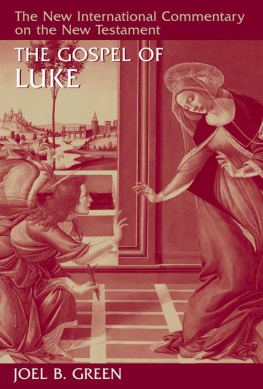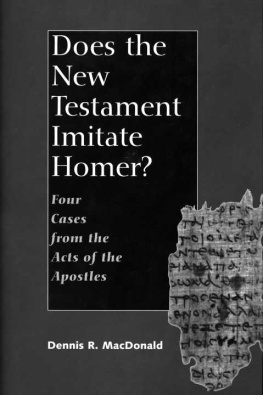Guide

Stephen S. Liggins
Many Convincing Proofs
Beihefte zur Zeitschrift fr die neutestamentliche Wissenschaft

Edited by
Carl R. Holladay, Matthias Konradt, Hermann Lichtenberger, Judith Lieu, Jens Schrter and Gregory E. Sterling
Volume 221

ISBN 978-3-11-045970-8
e-ISBN (PDF) 978-3-11-046037-7
e-ISBN (EPUB) 978-3-11-046019-3
ISSN 0171-6441
Library of Congress Cataloging-in-Publication Data
A CIP catalog record for this book has been applied for at the Library of Congress.
Bibliographic information published by the Deutsche Nationalbibliothek
The Deutsche Nationalbibliothek lists this publication in the Deutsche Nationalbibliografie; detailed bibliographic data are available on the Internet at http://dnb.dnb.de.
2016 Walter de Gruyter GmbH, Berlin/Boston
www.degruyter.com
Acknowledgements
This book (and the PhD thesis upon which it was based) could never have been completed without the generous support and assistance of many people.
First, I would very much like to express grateful appreciation to my PhD supervisors Professor Iain Gardner (University of Sydney), Dr Bill Salier (Moore Theological College) and Dr Brian Rosner (Moore Theological College) for their support and for the many hours of work that they put into this project. Second, I am greatly indebted to Dr Peter Bolt (Moore Theological College) and Mr Vanda Gould for their extremely generous assistance and encouragement at key times. Third, my doctoral examiners provided incisive feedback that has helped sharpen my arguments. Fourth, the staff of the Moore Theological College Library has been invariably friendly and helpful in locating and helping me to retain research material. Fifth, the faculty of the University of Sydney Department of Studies in Religion and also the faculty of Moore Theological College helped in various ways. Sixth, I benefited from the camaraderie and prayers of the other students in the Moore Theological College Postgraduate Studies Room. Seventh, I appreciated the support and assistance of the staff and members of Toongabbie Anglican Church and Anglican Churches Springwood the churches at which I served throughout the writing process. Eighth, when it came time to convert my thesis into a book suitable for the BZNW series, Mr Stefan Selbmann at De Gruyter was very helpful, patient and efficient in assisting me to improve the form and content of my work. My greatest earthly support throughout this whole enterprise has been undoubtedly been my wife Shareen. I am so grateful for her encouragement in undertaking this project, and her unfailing love and multi-faceted support throughout it! Finally, first and foremost, I am absolutely and thankfully indebted, in more ways that I can express, to God for so many things, including the opportunity to participate in and complete this project.
I hope that, in some way, this book will be of assistance to those who read it.
Soli Deo Gloria
Note on references and style
The main section of the bibliography includes all works cited in the thesis. There is a separate section for works, not specifically cited but which were influential on my thinking. The bibliography, footnotes and in-text references have been based on the guidelines set forth in Patrick H. Alexander et al., eds, The SBL Handbook of Style: For Ancient Near Eastern, Biblical, and Early Christian Studies , (Peabody: Hendrickson, 1999). So as to facilitate accessibility, where the SBL Handbook provides English titles for ancient primary source material, these have been used rather than the Latin titles.
English quotations from the Bible are from the New International Version, 1984. English quotations from the Apocrypha are from the New Revised Standard Version, 1989. English quotations from the Pseudepigrapha are from James H. Charlesworth, ed., The Old Testament Pseudepigrapha: Volume 1 (London: Darton, Longman & Todd, 1983) and James H. Charlesworth, ed., The Old Testament Pseudepigrapha: Volume 2 (Garden City, New York: Doubleday, 1985). English quotations from the Qumran documents are from Geza Vermes, The Complete Dead Sea Scrolls in English (London: Allen Lane / Penguin, 1997). English quotations from the Mishnah are from Jacob Neusner, The Mishnah: A New Translation (New Haven: Yale University Press, 1988). English quotations from the Babylonian Talmud are from Jacob Neusner, The Talmud of Babylonia: An Academic Commentary (Atlanta: Scholars Press, 199499). Where English quotations from other ancient primary sources have been used, the source of the translation has been noted.
English translations of German material are my own.
Abbreviations
Abbreviations in both text, footnotes and bibliography have been based on the guidelines set forth in The SBL Handbook of Style: For Ancient Near Eastern, Biblical, and Early Christian Studies , Patrick H. Alexander et al., eds. (Peabody: Hendrickson, 1999). The following abbreviations are used in the quotations of primary sources and references to lexicons.
| BDAG | Danker, F. W., W. Bauer, W. F. Arndt, and F. W. Gingrich, eds. A Greek-English Lexicon of the New Testament and Other Early Christian Literature . 3 rd ed. Chicago: University of Chicago Press, 2000. |
| CIL | Corpus inscriptionum latinarum |
| FGH | Die Fragmente der griechischen Historiker |
| IGR | Inscriptiones Graecae ad res Romanas Pertinentes |
| IvE | Die Inschriften von Ephesos |
| L&N | Johannes P. Louw, Eugene A. Nida, Rondal B. Smith, and Karen A. Munson, eds. Greek English Lexicon of the New Testament: Based on Semantic Domains: Introduction and Domains . Vol.1 of 2 vols. New York: United Bible Societies, 1988. |
| LCL | Loeb Classic Library |
| LSJ | Liddell, H. G., R. Scott, and H. S. Jones, eds. A Greek-English Lexicon . 9 th ed. with revised supplement. Oxford: Clarendon, 1996. |
| NewDocs | New Documents Illustrating Early Christianity . |
| SEG | Supplementum epigraphicum graecum |
| TDNT | Gerhard Kittel and Gerhard Friedrich, eds. The Theological Dictionary of the New Testament . Translated by Geoffrey W. Bromiley. 10 vols. Grand Rapids: Eerdmans, 196476. |
| UBS | Aland, Barbara, Kurt Aland, Johannes Karavidopoulos, Carlo M. Martini, and Bruce M. Metzger, eds. The Greek New Testament . 4 th rev. ed. Stuttgart: Deutsche Bibelgesellschaft/United Bible Societies, 1983. |
Chapter 1
Introduction
1.1Topic and approach
This book examines the key persuasive phenomena associated with Lukes presentation of evangelistic proclamation in Acts. In particular, it seeks to determine the impact of these phenomena upon the early audiences of Acts that is, those people who heard (or read) the narrative in the first decades after its completion.
While there have been various studies examining the contents of the evangelistic proclamation (i.e., the gospel message) in Acts; and various studies examining, from one angle or another, individual persuasive phenomena in Acts (e.g., the use of the Jewish Scriptures); no individual studies have sought to identify Lukes presentation of the key persuasive phenomena , or to analyse their impact upon Acts early audiences.



